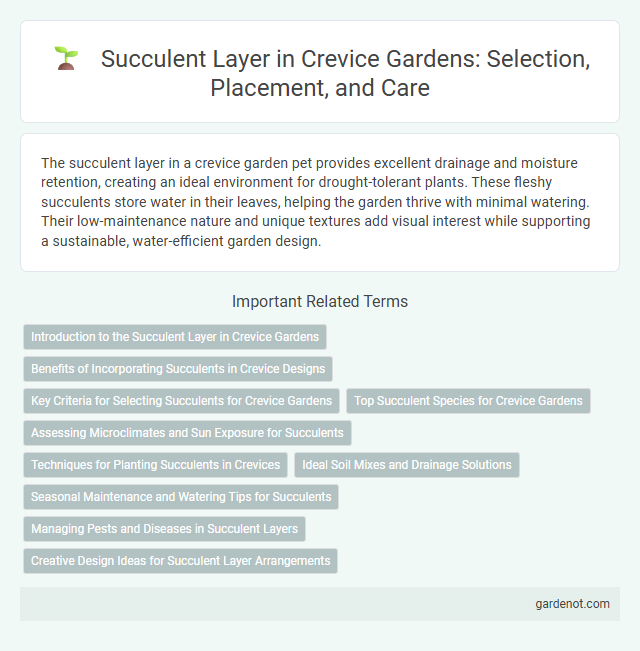The succulent layer in a crevice garden pet provides excellent drainage and moisture retention, creating an ideal environment for drought-tolerant plants. These fleshy succulents store water in their leaves, helping the garden thrive with minimal watering. Their low-maintenance nature and unique textures add visual interest while supporting a sustainable, water-efficient garden design.
Introduction to the Succulent Layer in Crevice Gardens
The succulent layer in crevice gardens consists of drought-tolerant plants adapted to thrive in narrow, rocky spaces with minimal soil and water retention. These succulents possess water-storing tissues that enable them to survive harsh conditions typical of crevice environments. Popular species include Sedum, Sempervivum, and Echeveria, which contribute to the garden's resilience and unique textured appearance.
Benefits of Incorporating Succulents in Crevice Designs
Incorporating succulents in crevice garden designs enhances water efficiency due to their drought-resistant nature and minimal irrigation needs. Succulents' shallow root systems stabilize soil within crevices, reducing erosion and maintaining structural integrity. Their diverse textures and colors increase biodiversity and aesthetic appeal while supporting pollinators like bees and butterflies.
Key Criteria for Selecting Succulents for Crevice Gardens
Succulents selected for crevice gardens should exhibit strong drought tolerance and compact root systems to thrive within narrow stone gaps. Species like Sedum, Sempervivum, and Delosperma are preferred due to their ability to withstand extreme sun exposure and minimal soil. Attention to growth habit and hardiness zones ensures long-term survival and minimal maintenance in crevice garden environments.
Top Succulent Species for Crevice Gardens
The succulent layer in crevice gardens thrives with species like Sedum, Sempervivum, and Delosperma, known for their drought tolerance and ability to anchor in narrow spaces. Sedum morganianum, Sedum hispanicum, and Sempervivum tectorum provide vibrant foliage and flowers while requiring minimal soil depth. These top succulent species optimize water retention and adapt to the microclimate of crevice gardens, enhancing both aesthetics and resilience.
Assessing Microclimates and Sun Exposure for Succulents
Succulents thrive best in well-defined microclimates within a crevice garden, where variations in sun exposure and airflow create ideal growing conditions. Assessing these microclimates involves measuring sunlight duration, intensity, and protection from prevailing winds to prevent stress and sunburn on succulent leaves. Understanding these factors ensures optimal placement of succulents, promoting healthy growth, water retention, and vibrant coloration.
Techniques for Planting Succulents in Crevices
Techniques for planting succulents in crevices emphasize selecting drought-tolerant species with shallow root systems, such as Sedum and Sempervivum, which thrive in minimal soil. Preparing a well-draining substrate composed of gritty sand, perlite, and minimal organic matter ensures optimal moisture control and prevents root rot. Strategic placement of plants within narrow gaps maximizes exposure to sunlight while allowing air circulation, promoting healthy growth and long-term survival in challenging microhabitats.
Ideal Soil Mixes and Drainage Solutions
Succulents in crevice gardens thrive in well-draining soil mixes composed of coarse sand, perlite, and organic matter that mimics their natural rocky habitats. Incorporating grit or small gravel enhances aeration, preventing root rot and ensuring rapid moisture evaporation. Optimal drainage is achieved by layering drainage materials such as crushed stones beneath the soil to maintain consistent airflow and water runoff.
Seasonal Maintenance and Watering Tips for Succulents
Succulent layers in crevice gardens require minimal but consistent watering, ideally once every two weeks during active growth seasons to prevent root rot while ensuring hydration. Seasonal maintenance involves removing dead leaves and pruning to promote airflow and reduce pest infestations, particularly during spring and fall. Applying a well-draining soil mix and adjusting watering frequency in response to temperature fluctuations are critical for maintaining succulent health year-round.
Managing Pests and Diseases in Succulent Layers
Effective pest and disease management in succulent layers involves regular inspection for common issues such as mealybugs, aphids, and fungal infections. Applying horticultural oils or insecticidal soaps helps control infestations without harming the plants. Maintaining proper drainage and airflow reduces the risk of root rot and mold, enhancing the overall health of the succulent layer in crevice gardens.
Creative Design Ideas for Succulent Layer Arrangements
Succulent layer arrangements thrive by incorporating varied textures, colors, and heights to create visually striking crevice gardens. Use a combination of rosette-form succulents, trailing varieties, and tall, spiky species to maximize depth and dimension within narrow spaces. Strategic placement of succulents with contrasting foliage and dynamic shapes enhances aesthetic appeal while promoting healthy growth in well-drained crevice environments.
Succulent layer Infographic

 gardenot.com
gardenot.com